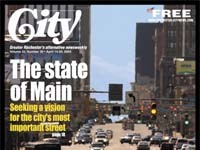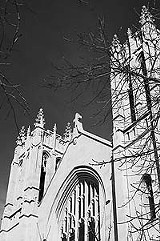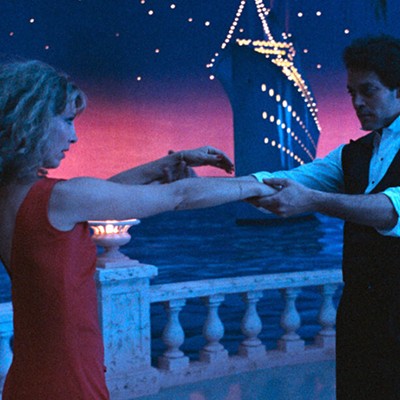[
{
"name": "500x250 Ad",
"insertPoint": "5",
"component": "15667920",
"parentWrapperClass": "",
"requiredCountToDisplay": "1"
}
]
Talk about retro.
When you read the religious tracts about planned renovations at Sacred Heart Cathedral --- the Bishop of Rochester's home church on Flower City Park --- you have to wrap your tongue around some Latin.
Like domus Dei and domus ecclesia, seemingly esoteric phrases that define the debate over Sacred Heart.
It comes down to one versus the other. (There's crossover, too, about which more later.) Will the cathedral be a house of God, where worshippers flock to receive transmissions from the deity? Or will it be a house of the people of God, where --- in a serious and sincere manner --- the worshippers talk back a little?
Why all the fuss?
Well, some parts of the renovation plan --- like basic maintenance work on the 80-year-old building's roof and walls, and improved accessibility --- are uncontroversial. Likewise upgrades to the sound system, lighting, and restrooms. But some more novel elements of the plan --- like a new side entrance --- have prompted criticism. Then there's cost: Repairs and utility upgrades alone will run more than $2.5 million; critics peg the total cost at $6 to $8 million.
To see the sparks fly, though, you have to look at an interior focal point.
According to a backgrounder from the Diocese, the cathedral's half-century-old high altar and canopy will be removed. "A new altar will be designed," says the backgrounder, "and placed on a raised platform near the crossing of the transepts, or side seating areas." Why go to the trouble? "The altar should not be raised up, turned away and distant from us... The pulpit, rather than being high over our heads, as if the Word of God was not meant for us on Earth, should also be like Jesus Christ, standing in [our] midst..."
Bishop Matthew Clark's office did not return our call. But on the diocesan website (www.dor.org), Clark writes of a need to "restore Sacred Heart so that it conforms to the norms of our church as they apply to the structure, décor, and appointments of cathedral churches." Another document on the website talks of "helping an old building to fulfill its original purpose," that is, foster the best atmosphere for worship. "The Church in the Middle Ages understood itself in the maxim Ecclesia semper reformanda, the Church is always reforming. One of the things that the Second Vatican Council reformed was the Mass. 'In the restoration and promotion of the sacred liturgy,' the Council taught, 'the full and active participation by all the people is the aim to considered before all else.'"
Phrases like "full and active participation" suggest a relocation of the spiritual center of gravity. The priest no longer celebrates the Mass mostly with his back to a nave of relatively passive worshippers. The worshippers themselves are something more than the "flock" they were.
All this is connected to the Second Vatican Council of the 1960s, specifically its call for "liturgical renewal." You could call it democratic renewal, too.
"The reason for the new focus on the assembly is derived precisely from the recovered role of the people of God during acts of worship." So said Father Richard Vosko in the National Catholic Reporter three years ago. The Albany-based Vosko has counseled the Rochester Diocese on its Sacred Heart plan, and his ideas have inspired dozens of Catholic church renovations in the US and Canada
Vosko's ideas have also set off conservative counterattacks in Los Angeles, Milwaukee, and other cities.
Enter Rochester's Sacred Heart Preservation Committee, which sees "massive destruction and desecration" ahead. "We are opposed to the plans of dismantling our beautiful, historic [cathedral] and reconfiguring this English Gothic masterpiece," says a committee statement. The statement adds that Sacred Heart is associated with the late Bishop Fulton J. Sheen --- "considered by many to be the most influential Catholic leader in America during the 20th century."
But Committee members aren't limiting themselves to giving advice. In recent months, they've been fighting the Rochester Planning Commission's denial of landmark status for the cathedral. (A lawsuit has been on hold since the original judge in the case recused himself.) And they've hired a canon lawyer, the Rome-based Alan Robert Kershaw, to take their ecclesiastical case straight to the Vatican.
Barbara Fredericks, a Dewey Avenue area resident, is one of the named plaintiffs in the lawsuit against the Planning Commission, along with her husband, Jan. The cathedral "has been part of our lives, and our children's lives, for 25 years," she says, adding she attends Mass there daily. And the suit, she says, "is a step to preserve the faith by preserving the integrity of the building."
Exactly how does this relate to matters of faith?
Essentially, Fredericks disputes the core of liturgical renewal. She believes the floor plan needs to reflect a division of power. "God is the center of the church; that church is His," she says. "The nave is where the people sit, and God is in the sanctuary. God is front and center, enthroned in the tabernacle... Some things are immutable. The body and blood of Christ will always be the same... How we act in church is fundamental to what we believe. We simply don't want to take God out of our [church]."
There are already enough "theaters" in town, she adds.
Fredericks insists this isn't a left-versus-right disagreement. "The Church," she says, "is neither liberal nor conservative, but orthodox, centrally focused on Christ."
However, Fredericks herself has struck a conservative stance when addressing at least one other liturgical issue: Two years ago, she told Democrat and Chronicle writer Jim Memmott that non-ordained people lack the "sacramental privilege" to deliver sermons in church. (Under Bishop Clark, the diocese has shifted toward allowing non-ordained people --- including women --- to preach under certain guidelines. Clark has also drawn hot fire for other transgressions, like outreach to gays and lesbians.)
Yet the ideological lines are not crisply drawn here.
For example, radical Catholic Dr. Harry Murray, a Nazareth College sociology professor, says he opposes the renovations. The Diocese, he says, should do only the work necessary to preserve the cathedral's "structural integrity" and direct its resources toward fighting poverty.
Another Nazareth prof, medieval historian Timothy Thibodeau, acknowledges that "terrible things" have been done to some church interiors. "I'm thinking of things that happened in the 1970s," he says. "It's a no-win issue for both sides." Nor is it simply about nostalgia. "The question is, who owns the Church?"
These disputes go way back, says Thibodeau. In the beginning, he says, Christians altered the design of the Roman basilica. Around the year 800, he says, they "took the 'box' and made it cruciform." The new design --- the classic cathedral, whose floor plan represents the cross --- spread across Europe.
"The theology was always catching up with the architecture," says Thibodeau. Through the centuries, he says, iconoclasts (breakers of images) and traditionalists often battled each other. "In the Middle Ages, the educated referred to churches as 'books for the illiterate.'" That is, all the design elements, ornamentation, statuary, and other features conveyed something beyond words, something ineffable to make the spirit soar.
"We really have not had the fruit of the liturgical renewal we should have, in terms of architecture," says Father Charles Curran, a Rochester priest now teaching at Southern Methodist University. The point, says Curran, who's the bane of Church conservatives for his liberal views, is "to bring everybody actively into it."
What would Curran do? He confesses he hasn't been following the Sacred Heart story closely. Yet his prescription would be far-reaching: "If I had my way, I'd take all the pews out, for one thing." In the old days, he says, people stood during worship.
Speaking of Sacred Heart
-
News briefs 5.7.03
May 7, 2003 -
Reader Feedback 4.2.03
Apr 2, 2003 - More »
Latest in News
More by Jack Bradigan Spula
-

The state of Main
Apr 14, 2004 -
School improvement: the price is wrought
Apr 7, 2004 -
Hour of power
Mar 31, 2004 - More »






